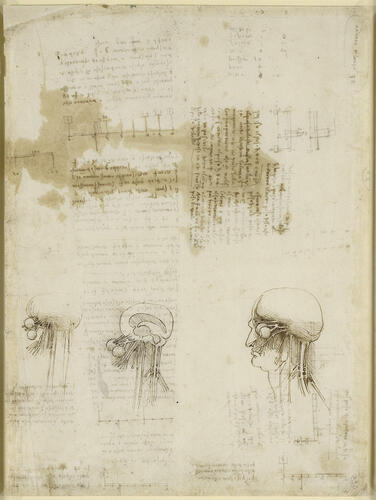-
1 of 253523 objects
The nerve pathways to the brain; Notes on weight and statics, with diagrams c.1509-10
Recto: Pen and ink over traces of black chalk. Verso: Pen and ink | 29.0 x 21.4 cm (sheet of paper) | RCIN 912602
-
Recto: three sections of the head, showing the eyes and brain with ventricles, nerves and arteries.
On this sheet Leonardo finally abandoned any attempt to connect the nerves with the ventricles of the brain, or to locate the mental faculties within those ventricles. Leonardo’s injection of wax into the brain, recorded in 919127, had revealed that the form of the ventricles was much more complex than the traditional three bulbs seen in 912603. On 919127 he still labelled the lateral ventricles imprensiva, the third ventricle senso comune, and the fourth ventricle memoria, wishing to locate the mental faculties within the ventricles, but he wrote: "Since we have clearly seen that the [fourth] ventricle a is at the end of the spinal cord where all the nerves which give the sense of touch come together, we can judge that the sense of touch passes into this ventricle, since Nature operates in all things in the shortest time and way possible." In other words, he believed that the spinal cord passed into the fourth ventricle, but he still labelled that ventricle memoria. We can sense the tension between theory and observation, and observation was starting to prevail. On a stray sheet from his Anatomical Manuscript B, now in Weimar, the ventricles are again labelled with the faculties, but the cranial nerves and spinal cord stream to the base of the brain with no apparent connection to the ventricles or faculties.
The spinal cord and some of the cranial nerves are shown connecting to the brain. To the front of the brain are the olfactory tracts (associated with cranial nerve I or CNI) and the eyes, optic nerves, optic chiasm and optic tracts (CNII). Below are the maxillary and mandibular nerves, shown with separate points of origin on the brain though they are in fact divisions of the trigeminal nerve (CNV); its third division, the ophthalmic nerve, is not shown. The vagus nerves (CNX) are seen travelling from the midpoint of the brain vertically downwards (cf. 919050v). Either side of the spinal cord are the pair of ancillary nerves which Leonardo had erroneously shown travelling within the cervical vertebrae in 919021 and 919040, together with a portion of the brachial plexus.
Verso: various notes and diagrams on weight.
Text adapted from M. Clayton and R. Philo, Leonardo da Vinci: Anatomist, London 2012Provenance
Bequeathed to Francesco Melzi; from whose heirs purchased by Pompeo Leoni, c.1582-90; Thomas Howard, 14th Earl of Arundel, by 1630; Probably acquired by Charles II; Royal Collection by 1690
-
Creator(s)
Acquirer(s)
-
Medium and techniques
Recto: Pen and ink over traces of black chalk. Verso: Pen and ink
Measurements
29.0 x 21.4 cm (sheet of paper)
Other number(s)

